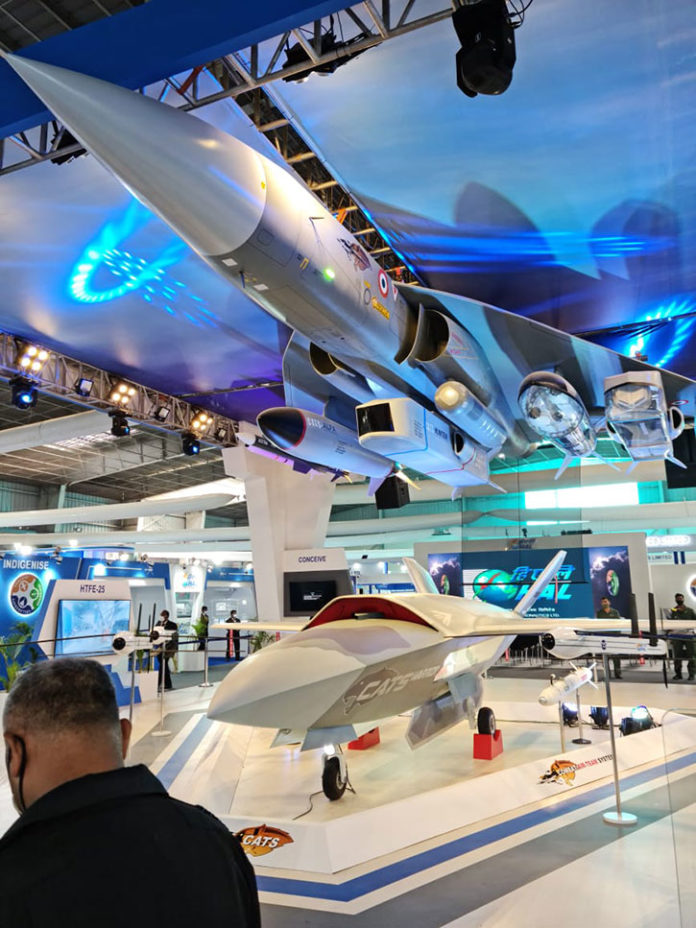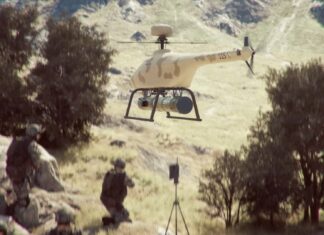
India’s leading aerospace manufacturer Hindustan Aeronautics Limited (HAL) unveiled today the Combat Air Teaming System (CATS) at the Aero India airshow in Bengaluru. CATS aligned with similar teaming concepts underway in the USA and Europe, integrating manned and unmanned aerial platforms in cohesive, dynamic future air combat.
At Aero India, HAL showcases several elements of CATS, including the large CATS WARRIOR low-observable drone designed as a weapon carrier. Several WARRIOR drones will join the manned fighters before they are detected by the enemy, to create a strike force. Each manned fighter will be able to command several WARRIORS, that will employ artificial intelligence to operate as team members. They will carry sensors, defensive and offensive weapons to support the mission. The Warrior mock-up visible at the show this year is seen with an internal weapons bay deploying a DRDO Smart Anti-Airfield Weapon (SAAW ).
Designed with low observable characteristics, the WARRIOR drones will penetrate the defended zone and strike their targets with minimal attrition, enabling the manned aircraft to stay out of danger. This concept provides force multipliers for the IAF Tejas, by maximizing their effectiveness while reducing the risk to pilots and aircraft in a future combat engagement. “The Warrior, structurally a sort of a cross between Boeing’s Air Power Teaming System (ATS) and the Kratos Valkyrie loyal wingman drone system, is to be a teaming drone that functions with assets that will include the LCA Tejas as well as the Rafale,” LiveFist commented.
The first Warrior prototypes are expected to fly within three to five years and is being funded by Hindustan Aeronautics (HAL).
As a large drone, WARRIOR will be too big to be carried on fighter planes, and therefore, will have to deploy from transport aircraft or be launched from the ground. The HUNTER, shaped like a cruise missile, is a different member of CATS, designed for carriage on strike aircraft. This air-launched cruise missile (ALCM) has a range of up to 250 km weighs over 600 kg and carries a payload of 250 kg. This payload can be a unitary warhead or submunitions. The missile will use multiple navigation systems, including global navigation satellite (GNSS) system, terrain, and image-based navigation, and employ automatic target acquisition and imaging seeker for the terminal attack phase.
Powered by a turbojet engine CATS HUNTER could be integrated with Tejas MK1A, Mirage 2000, and Su-30MKI aircraft, extending those platform’s stand-off strike capabilities within the new Air Launched BRAHMOS and Rafale’s SCALP, twice over India’s current stand-off air-launch weapons – the Crystal Maze and SPICE 2000 weapons.
CATS may also offer another surprise – acting as a delivery platform for a swarm of folded miniature ‘suicide drones’. The mini-drones are deployed at a distance ahead of their targets, their wings and tails are unfolded and electrical motors activated, accelerating the drones at a speed of 100 km/h toward their targets. Each drone has a battery pack sustaining a flight for few hours. The drones are fully networked with each other through electronic datalinks. Using their infrared and electro-optical sensors, they detect targets such as surface-to-air missile units, enemy radars and aircraft on the ground. Each drone is designed to be smart enough to ‘learn’ about what it detects before targets are assigned to individual drones. Together, the drones employ swarm tactics to search and detect (by AI/ML) and defeat those targets by attacking at the most sensitive location with their (relatively small but accurate) warheads.
Newspace Research and Technologies, the drone designer, and HAL unveiled the Air-Launched Flexible Assets – Swarm (ALFA-S) at Aero India in 2019. The weapon is slated to be part of the JAGUAR MAX upgrade plan but it could also operate by advanced trainers such as the HAWK Advanced Jet Trainers or transport aircraft that can carry the container.
Hindustan Aeronautics Limited, which has been working on drone warfare concepts for more than five years. The impressive display at Aero India 2021 indicates HAL has advanced towards the design, development and integration of key subsystems of CATS. But, to become a reality, the eventual users – the air forces – must reshape their operational philosophies around the concept of ‘combat-teaming’ to effectively integrate and use such futuristic assets.
More pictures of Unmanned Wingman UCAV at #AeroIndia2021 .
This UCAV is designed to perform as a wingman to the mother ship which a real fighter aircraft with a pilot. This Unmanned wingman UCAV will engadge with air to air and air to ground targets. pic.twitter.com/Da7W9OMPsq
— Saptak Mondal (@saptak__mondal) February 1, 2021



















